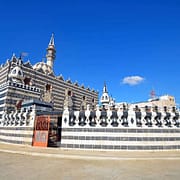Jordan Valley – An Exquisite Portrait Of Jordan’s Ancient Past
The Jordan Valley is said to be one of the most fascinating regions of the world. It is, to a great extent, like a giant portrait of Jordan’s long and colorful past. Because most tourists only have a very limited amount of time, our Egypt and Jordan generally don’t include a trip through the Jordan Valley. However, if you have the time, then it is a trip which we would certainly recommend.

The Great Rift Valley of Jordan, Jordan Valley.
If you have an interest in visiting ancient sites or other Jordan tourist attractions which are of significant historical importance, then a trip to Jordan should certainly be on the cards. More specifically, your itinerary should definitely include some time exploring the Jordan Valley, which is essentially part of the Great Rift Valley that stretches all the way to East Africa.
Travelers travelling from the northern reaches of the Jordan Valley to the south of the valley will be forgiven for thinking they’ve traveled through different countries. The changes in the landscape never fail to amaze. From the pleasant green habitable north, to the arid inhospitable desert in the south.
Ghor – The Food Bowl Of A Nation
The Jordan Valley consists of a number of sub-regions, with Ghor being the northernmost region. Because of its geographical location, the area is noticeably warmer than most of the country. This, together with the fact that the Jordan River flows through the area, has made it an ideal area for agriculture all year round.
Archaeologists and historians have established that humans started cultivating crops in the area approximately 10,000 ago. By 3000 BC many other regions in the country were dependent on the Ghor farmers for their supplies of fresh produce.
A 69 kilometer long canal was constructed during the 1950s in order to provide a reliable source of irrigation for the outlying areas of Ghor. In more recent times, an ever increasing number of farmers have turned to the use of portable greenhouses. The results have been spectacular, with the average farmer now producing around seven times as much produce as they were before the arrival of the greenhouses.
The Fall And Rise Of Ghor
From 1967 to 1971, following the conquering of the West Bank of the Jordan River by Israeli forces, the population declined drastically from an estimated 60,000 to only around 5,000. However, as new infrastructure arrived, more villages became established, and the population once again increased. Today, Ghor in the Jordan Valley is home to about 100,000 people, despite the fact that there are no major cities anywhere along the River Jordan.
The River Jordan From Beginning To End
There is no one definitive starting point for the Jordan River but it is safe to say that it starts in Syria. From the Anti-Lebanon Mountains in Syria, the Jordan River makes its way to the Sea of Galilee in Israel. Although the Sea of Galilee is only a relatively small lake, it is certainly the most famous lake, and it’s revered by Christian pilgrims.
This is reportedly where Jesus walked on water; where he calmed a storm, and where he fed thousands of starving people.
The Dead Sea And The End Of The River Jordan
Flowing out the opposite end of the lake, the River Jordan continues on its way until it finally drains into the Dead Sea, which coincidentally, happens to be the lowest point on the planet, at around 400 meters below sea level.
The Dead Sea, which features in nearly all of our Egypt and Jordan combined tours, might not be a sea, but it is most certainly dead. There are no signs of plant or animal live whatsoever. Whereas typical sea water has a salt content of about 4 grams per liter of water, the Dead Sea has a salt content of around 35 grams per liter. Despite its lack of fauna and flora, it is a rich source of nutrients and minerals.
Beyond The Dead Sea And Into The Desert
Beyond the Dead Sea, the Jordan Valley becomes home to Wadi Abada, otherwise known as the Arabah Desert. Nonetheless, visitors that continue south will find countless historical sites, including the Valley of Salt with its spectacular natural salt formations.
Biblical scholars also believe that it was somewhere in the Jordan Valley where David was able to kill 18,000 Edomites, finally defeating them and then annexing their land. The Valley of Salt is also believed by some to be the place where Sodom and Gomorrah were destroyed by God.
Visiting The Jordan Valley From Egypt
The Jordan Valley is a treasure trove of historical Jordanian attractions waiting to be explored, and even more so for those who are passionate about biblical teachings. Experience the very best of Jordan in comfort and style with one of our epic Egypt and Jordan combined tours.
Last Updated on July 11, 2020
















